Building a Better Builder
By Mento 3 Comments
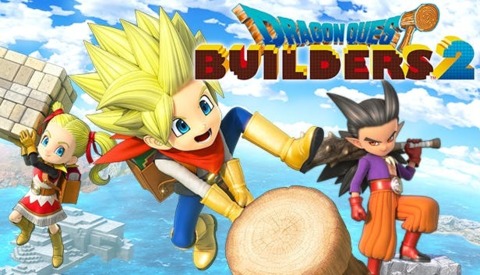
So... I've been watching a lot of Hololive (a VTuber talent agency of sorts) clips of late and recently they've all been playing a lot of Minecraft after the servers for the Japanese and English-speaking members were combined. It's been cute seeing both sides struggle with the language barrier when encountering each other, but more than that I've been impressed by all the elaborate construction projects everyone's been showing off to their newly connected neighbors. It gave me the itch to get back into a construction sim in a big way too, and therefore it seemed the perfect excuse to dust off this copy of Dragon Quest Builders 2 I picked up last year to see how Square Enix and Omega Force have improved upon Dragon Quest Builders 1.
For a while, the gameplay experience felt very similar. The progression of the first island, for instance, teaches you all about the sequel's new farming mechanics but couches it narratively in a familiar riff on the first game's poison country and how all its quests revolved around purifying enough of the terrain to make a sanctuary for travellers. Despite these story similarities though, the game is filled with major, sweeping changes to the core mechanics and is much more confident and expansive in its approach; I get the sense that it acquired a more concrete idea of what an audience wants from a Minecraft clone, which is to say A) a greater sense of freedom unfettered by too much linear quest progression of the type that usually defines a regular entry in the Dragon Quest series, and B) the opportunity to keep expanding a permanent location instead of continually starting over with new parameters and goals.
As such, while this series continues to walk a delicate line between giving players not enough direction and too much, DQB2 finds a better balance than its predecessor while also addressing the issue of the first game's non-permanent locales: while you still have similar "scenario" towns to build from scratch each time, the central location of the Isle of Awakening is a persistent and enormous landmass that awaits continual development. In-between your time on these story-based islands, you can spend hours just renovating and constructing the Isle of Awakening's Minecraft-ian blank canvas world: the chief motivation to complete these story islands then becomes unlocking many more crafting recipes, room plans, building blueprints, and other unlocked mechanics and tools to improve your "home base." It's an intelligent compromise between the original game's goal of turning Minecraft into something more directed and quest-focused, completing objectives in a manner akin to constructing LEGO kits from a set of instructions, and the appealing open-ended creativity of same.
Moreover, there's so many welcome changes to the extant DQB formula that I've found myself enjoying this sequel far more than the original game and, for my sake as much as anyone else's, I'd like to go through an itemized list of these superior additions to understand why this outing is that much more compelling. I should clarify that I'm only a couple islands into the game so far - the agricultural Furrowfield and the mining town of Khrumbul-Dun - but I'm thoroughly hooked in a way that I haven't been with a construction sim since Terraria all those many moons ago.
Tabula Raiser
On the Isle of Awakening, you're left to your own devices for the most part but the game still wants to give you some boundaries if only for the sake of not being totally overwhelmed by indecision. For instance, when you get back from the first island - which is all about creating arable land and partitioning and preparing parcels of tilled earth for growing specific types of crops - you're given some directions to make a similar farm back on the Isle of Awakening albeit with a much more generous land size.
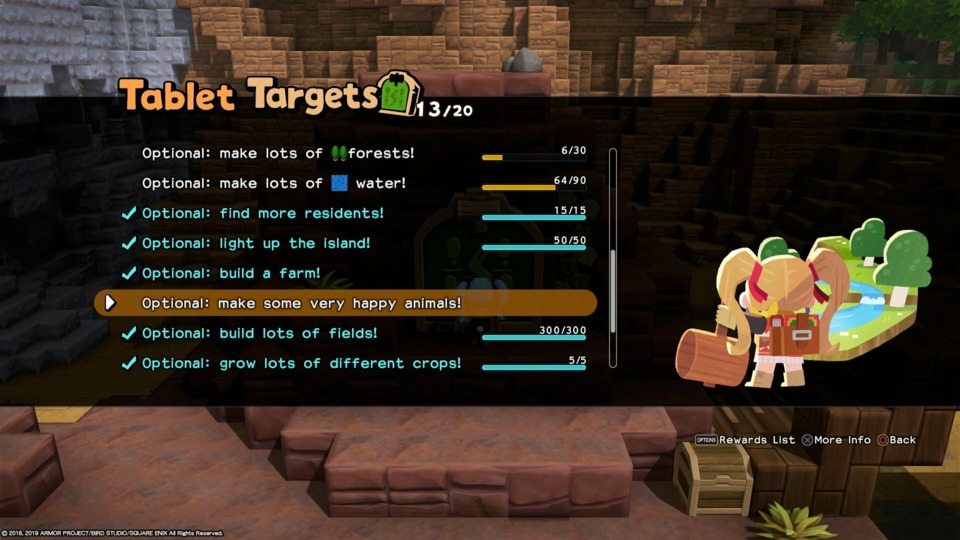
One of my favorite RPGs, Dark Cloud 2, also has its own building mode that operates mostly on vague objectives rather than the rigidity of Dragon Quest Builders's blueprints. Requisites like having a river of a certain length or building enough fencing to encircle a farm, but the shape of either is left to the player's discretion. On the Isle of Awakening, you're given a few direct goals and then a whole mess of optional ones to pursue and yet none of them are so specific as to restrict the player's creativity or agency when crafting their own settlement. If the goal is to make a restaurant, it's down to the player how large they decide to make their eatery and the themes and menus it might have. As you play more of the game and unlock more block types and furniture from geographically and culturally diverse islands there's a wide number of interpretations for those simple suggestions. I always work best with a goal in mind but I also enjoy the freedom in being able to build anything I want as long as it suits a required purpose.
Explorer Shores
In addition to the story islands and the Isle of Awakening discussed above, you can visit these proc-gen islands for some resource gathering. There's something like a No Man's Sky scavenger hunt for item types while there - which works simultaneously as a list of possible things to find if you're on the hunt for specific components - and scouting them all means unlocking an infinite amount of one resource in the rest of the game. Having infinite wood, for example, isn't just a medical condition any more: it's also a means to build as many wooden structures, or useful items like chest containers and platforms, as you'd like in either the Isle of Awakening or in the next chapter of the story.
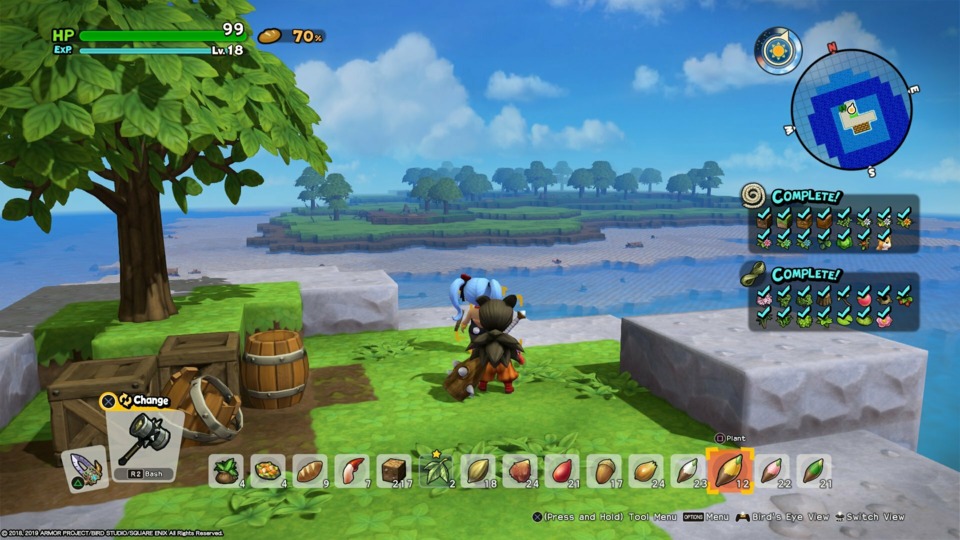
What I like most about explorer shores is that it offers a slightly different variation on the gameplay, in particular when contrasted with the Isle of Awakening. The Isle of Awakening is almost all building-related while Explorer Shores has no building at all, at least if you're doing it right, but is instead all resource-gathering and exploration. Its rewards are tangible and its scavenger hunt is something that can be made easier with certain upgrades during the story progression (I'm not far enough in to acquire it yet, but a certain tool will help you find missing resource types while jogging around). They're optional and mostly filler given their randomized nature, but those infinite resources are too tempting to pass up. I'm hoping for infinite stone and common metals next, since I've a hankering to build myself my own metal city like Vector from Final Fantasy VI.
Civil Engineering
One of my favorite little mechanics that makes itself known towards the end of each island is how you're tasked with creating a huge building with multiple floors, but suddenly everyone in town is inspired by all the building you've done and decides to pitch in. After a certain amount of solo input to get the ball rolling, the NPCs will not only gather the resources needed to complete this megalithic structure but will put down all the requisite pieces in addition. If you really want to build the entire edifice yourself, the blueprints for the floors stay with you so you can recreate them on the Isle of Awakening (though it will take much longer without all that extra help; fortunately, having infinite supplies of certain materials helps a great deal).
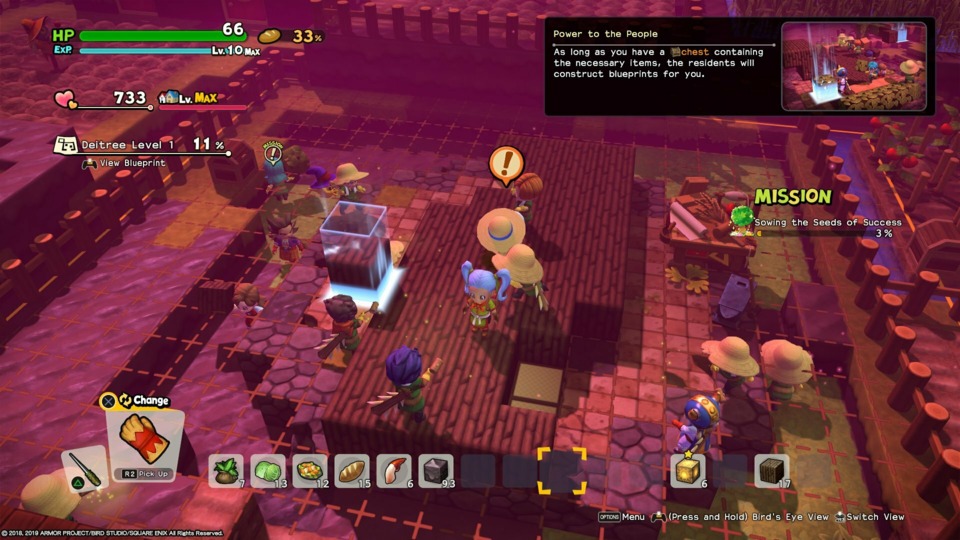
It feels like NPCs are just more useful in general in DQB2. While they still mostly stand around and occasionally give you requests for certain buildings with specific conditions, many of them will join you in fighting off the occasional attacking horde of monsters and most pull their weight in other, career-oriented methods. The farmers plant and harvest a lot of crops, the miners fetch up large supplies of metal ores each day/night cycle, and so on. Everyone also drops gratitude points: the game's chief currency, one used to expand the size of the towns during the story mode and spent on acquiring new item crafting recipes on the Isle of Awakening. As long as you've built a town that attends to their various needs, they will if nothing else be a constant supply of happiness cash.
Dragon Quality of Life: Fast Travel, No-Loss Respawns, Endless Inventory, and Gliding
As well as the more overt mechanical additions, it feels like DQB2 is just more hospitable in general. There's a fast travel system that makes getting around convenient and doesn't require farming Chimaera Wings from specific mobs (usually only found in high-up places), you acquire a means of gliding over long horizontal stretches before the end of the first island, and any death just spawns you back in the nearest settlement during the daytime with no loss of items. Best of all, the game quickly eliminates inventory limits by introducing a bag that has near-infinite carrying capacity: you are limited to what you can hold in your "active bar" but anything else can be dumped in a sack for future access and will also be available while crafting.
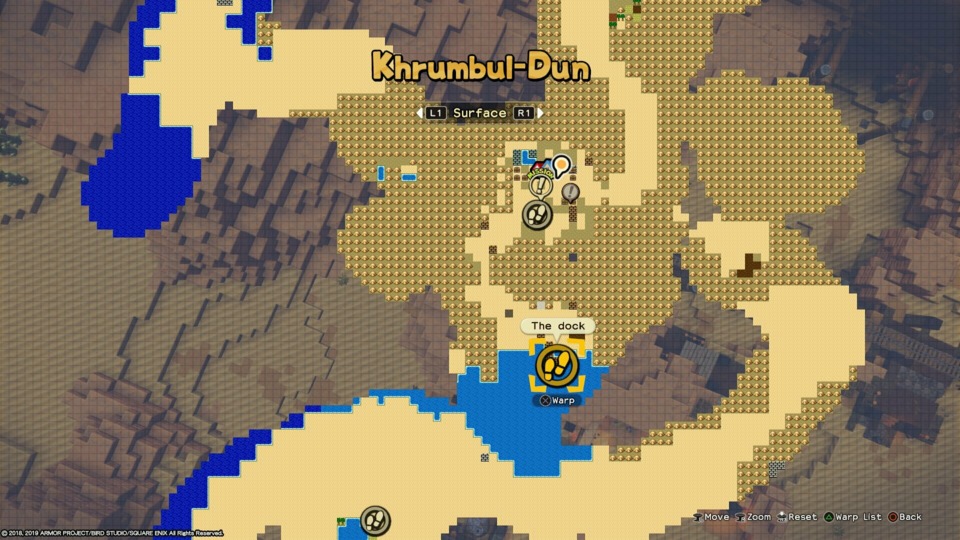
Death is often inevitable in these crafting sims, especially as your attention is frequently divided enough that it's easy for some beastie to get the drop on you, so ensuring that there's no repercussions for letting your concentration slip (or your entire body in the case of navigating a precarious walkway several tiles above ground) minimizes the amount of frustration involved if you're eager to get back to your construction task. Any given Dragon Quest is still going to throw its menagerie of cute, pun-named monsters at you regardless of whatever genre it happens to be appropriating that day but they're far less of a threat in this game: many types aren't even hostile, letting you initiate the encounter if they have drops you might need. Likewise, while the game still has the requisite boss battles where your entire settlement is at risk if you're unable to prevent the boss's attacks in time, the inspired populace will instantly rebuild everything as it was before the boss fight was initiated - no running around post-battle refilling blocks of dislodged earth for the sake of your perfectionism.
There's many other little helpful features, but with many of them I can't recall if they were in the original game too. Like how setting down a blueprint in the world means every component you need to finish it is highlighted in your inventory or in the crafting menu: there's never any ambiguity as to what you still need to complete the plan, and thus no need to keep checking over and over or writing down what's left to acquire.
Online Envy
I don't recall if it was in there or just not as prominent, but DQB2 frequently introduces impressive constructs from the online community via a notice board feature or the Explorer Shores. In the latter's case, you'll occasionally come across curated content just sitting in the wild - sadly, you can't take any of its components with you for fear of jumping ahead in the progression - and can explore it and study it in detail in case you want to recreate it. I don't think there's a way to download custom blueprints so you can build other projects yourself (unless I've not been looking hard enough or it's a post-game privilege). They also stick community creations in the loading screens, which is a novel place to put anything of value that isn't a tooltip (it has those too).
It feels like a no-brainer for a game based on creativity like this to implement a means to show off your big imagination to inspire others, but I don't recall the first game doing a whole lot with the conceit. Having them actually appear in the procgen Explorer Shores mode is a genius move, since it lets you poke around them like interactive dioramas, but I'm guessing the developers just have a selected handful that might appear.
